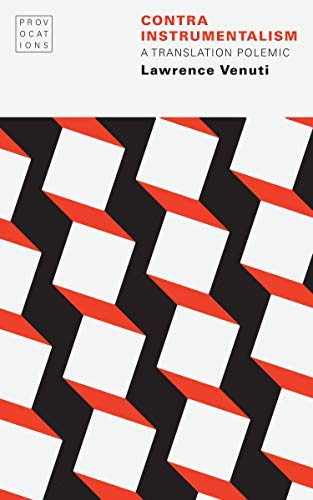
Where Is My Desire?
| By Chantal Wright |
| Issue 4 | February 13, 2020 |
It is a provocation, I know, to open a response to Lawrence Venuti’s Contra Instrumentalism – A Translation Polemic with a metaphor for translation, given the book’s substantive discussion of translation proverbs and their dangers. Why risk “belletrism” from the outset? But bear with me. Translator Maureen Freely’s comparison of the translator and the jazz musician, her metaphorical mapping of one domain (jazz) onto another (translation), allows us to see one thing in terms of something else, a situation that successful metaphors always facilitate, and hence to see differently. And who wouldn’t want to be mentioned in the same breath as John Coltrane, and have their work compared to his spiritual saxophonic soarings – and don’t we translators also lock ourselves in the room above the garage for weeks on end, to then emerge with our masterpiece, as Coltrane did with A Love Supreme? And isn’t, or shouldn’t, translation be something like Patricia Barber’s composition "Yellow Car” (surely itself a nod to “Blue Train”): a musical meditation on a melody (which is not an invariant, more of a stimulus or an impulse) resulting in a series of pieces that all appear under the same name, with one of the series a winkingly-entitled “Yet Another in a Long Series of Yellow Car” (for which, see Barber’s early album A Distortion of Love)?
The Invariance Effect: A Response to Lawrence Venuti
| By Stefan Helgesson |
| Issue 4 | May 12, 2020 |
The hard question is this: Are some translations better than others? People certainly seem to think so – at least in the world of publishing, reviewing, and prize-giving. In the UK, the British Comparative Literature Association runs the John Dryden Competition to honor particularly deserving translation achievements. In Stockholm, the international literary prize of Kulturhuset Stadsteatern goes both to the writer of the book and its Swedish translator. And in almost any review of a published literary translation, there will be some comment – however brief or poorly motivated – on the merits of the translation.
Where Is Your Desire?
| Lisa Foran |
| Issue 4 | November 12, 2020 |
Venuti’s polemic introduces a rhetorical force to many arguments he has made elsewhere about the importance of translation and the need for that importance to gain institutional recognition. At its best, it provides a welcome rebuttal of many myths about translation that remarkably continue to be retold by people who should know better. However, no counter-provocation worthy of the name could consist in praise only, and in this piece I take two issues with Venuti. The first is that at times his eagerness to point out the failings of others’ approaches to translation blinds him to their more positive contributions. As such, Venuti falls prey to a kind of instrumentalism himself in that he seeks a stable invariant failure in others’ missteps that is simply not always there. Secondly, the question of desire is key in that it is used to frame the polemic in both its introduction and conclusion. Yet, bizarrely, the translator’s desire remains almost entirely unaddressed throughout the work. I will come back to these issues further on, but for now let’s look at probably the most important contribution Venuti is making here, which is that of a translation model.
Contra Polemic
| V. Joshua Adams |
| Issue 4 | March 11, 2021 |
Venuti’s preferred model of translation does look both new and radical. Indeed, it appears so new and radical that it would make us question even our most instinctive, common-sense thinking about translation — like our instinctive, common-sense rejection of Guido as a translator. But in reading Contra Instrumentalism, that is not actually what happens; the radical promise of the book remains unfulfilled. The reason for this, I will suggest, is twofold. First, Venuti mischaracterizes the differences between his model of translation, which he calls “hermeneutic,” and its alternative, which he calls “instrumental.” Initially presenting these models as if they represent an either/or choice, he eventually concedes that they are not as opposed as they first appear. Second, Venuti mischaracterizes the relationship between translations and their sources. He writes as if translations replace sources when they actually represent them. Like the categorical distinction between hermeneutic and instrumental models of translation, this is a false picture, one that Venuti’s discussion of specific translations dispels. The radical theory of the book — which turns out to be less radical, and less coherent, than it appears — is also contradicted by its practice. This does not negate the necessity of Venuti’s polemic per se, but it does force us to reconsider where and how it might actually be profitably pursued. The real contribution of Contra Instrumentalism does not come from its theorizing but from its practical criticism. Here Venuti succeeds in pointing a way forward for translation studies, albeit in different terms than he might like.
Academic Business as Usual: A Reply to My Critics
| Lawrence Venuti |
| Issue 4 | February 1, 2023 |
To read through the “counter-provocations” to Contra Instrumentalism, each statement bristling with criticisms, is a bracing experience. But it is also somewhat discouraging to see that, among the respondents, my book has not provoked reactions that would develop in some productive direction the project I was trying to formulate. If my respondents had evaluated the book for a university press and I revised it to incorporate their responses, it would certainly have been much stronger as a work of scholarship. The genre would have been quite different, less polemical, less abrasive in attempting to change thinking about translation and more committed to exhaustive, even-handed research, more balanced in its criticisms and less theoretical in its pronouncements, less hit-and-run in singling out targets. Genre aside, the counter-provocations reinstate certain orthodoxies (the invariant, untranslatability, the creative writing model) that stray from my main project: to foster a hermeneutic approach to translation, in theory, history, and practice, where the aim is to illuminate the translator’s inscription of an interpretation and to articulate it with increasing precision.
